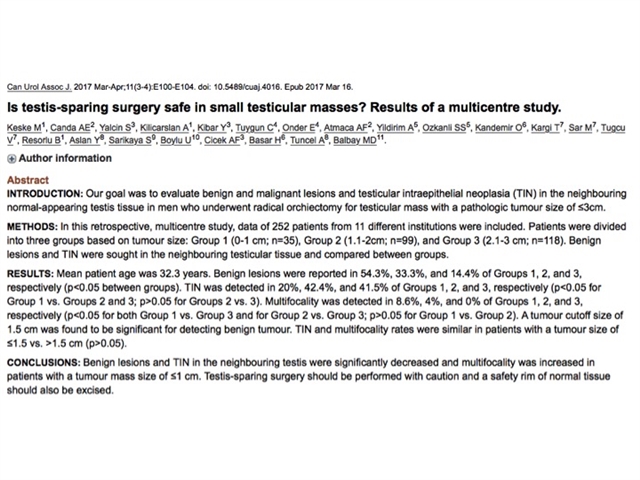
Can Urol Assoc J. 2017 Mar-Apr;11(3-4):E100-E104. doi: 10.5489/cuaj.4016. Epub 2017 Mar 16.
Is testis-sparing surgery safe in small testicular masses? Results of a multicentre study.
Keske M1, Canda AE2, Yalcin S3, Kilicarslan A1, Kibar Y3, Tuygun C4, Onder E4, Atmaca AF2, Yildirim A5, Ozkanli SS5, Kandemir O6, Kargi T7, Sar M7, Tugcu V7, Resorlu B1, Aslan Y8, Sarikaya S9, Boylu U10, Cicek AF3, Basar H6, Tuncel A8, Balbay MD11.
Author information
Abstract
INTRODUCTION:
Our goal was to evaluate benign and malignant lesions and testicular intraepithelial neoplasia (TIN) in the neighbouring normal-appearing testis tissue in men who underwent radical orchiectomy for testicular mass with a pathologic tumour size of ≤3cm.
METHODS:
In this retrospective, multicentre study, data of 252 patients from 11 different institutions were included. Patients were divided into three groups based on tumour size: Group 1 (0-1 cm; n=35), Group 2 (1.1-2cm; n=99), and Group 3 (2.1-3 cm; n=118). Benign lesions and TIN were sought in the neighbouring testicular tissue and compared between groups.
RESULTS:
Mean patient age was 32.3 years. Benign lesions were reported in 54.3%, 33.3%, and 14.4% of Groups 1, 2, and 3, respectively (p<0.05 between groups). TIN was detected in 20%, 42.4%, and 41.5% of Groups 1, 2, and 3, respectively (p<0.05 for Group 1 vs. Groups 2 and 3; p>0.05 for Groups 2 vs. 3). Multifocality was detected in 8.6%, 4%, and 0% of Groups 1, 2, and 3, respectively (p<0.05 for both Group 1 vs. Group 3 and for Group 2 vs. Group 3; p>0.05 for Group 1 vs. Group 2). A tumour cutoff size of 1.5 cm was found to be significant for detecting benign tumour. TIN and multifocality rates were similar in patients with a tumour size of ≤1.5 vs. >1.5 cm (p>0.05).
CONCLUSIONS:
Benign lesions and TIN in the neighbouring testis were significantly decreased and multifocality was increased in patients with a tumour mass size of ≤1 cm. Testis-sparing surgery should be performed with caution and a safety rim of normal tissue should also be excised.